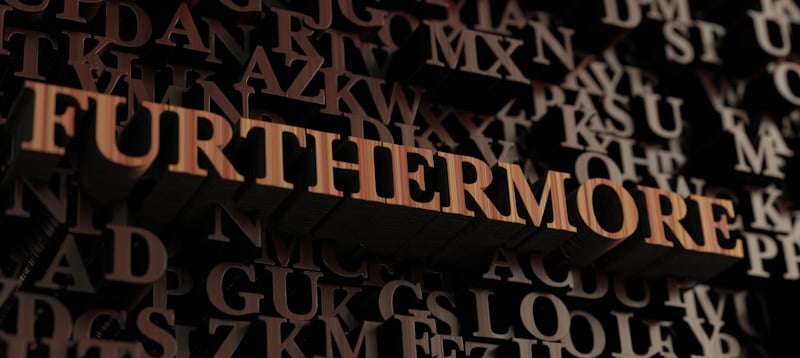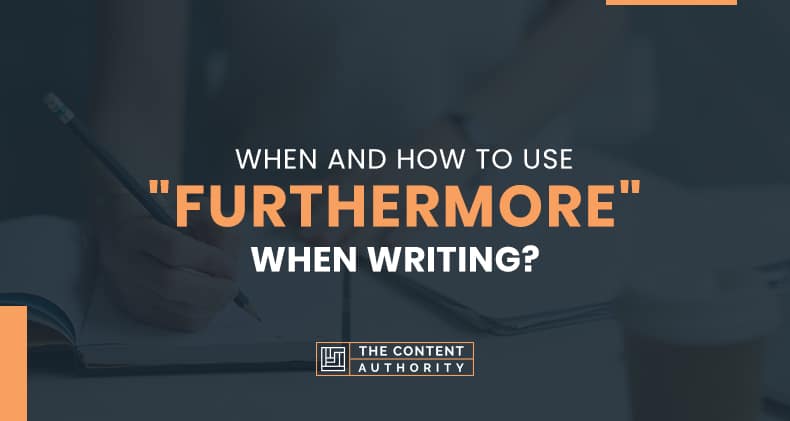To communicate one entire message in a single sentence is not always feasible. At times, the sentence should be broken down into two, or some kind of a mid-sentence pause – in the form of a comma, semicolon, conjunction, or conjunctive adverb – should be used. “Furthermore” is a term that can serve that very purpose.
The term “furthermore” helps bring together two related points. If a given point must be broken into two individual sentences without breaking the flow between them, “furthermore” helps. “Furthermore” adds on to what’s being already said. It’s doesn’t present a contrasting point, unlike “however”.
“Furthermore” or using the term in texts may seem straightforward. But that’s usually not the case, particularly when you consider the various punctuation rules surrounding the adverb, the different ways to position the term in a sentence, alternate words for “furthermore”, etc. Keep reading to learn everything that there’s to using the word in your texts.
“Furthermore” – Meaning
The word “furthermore” denotes “the continuation of a sentence immediately prior” so that it can provide the intended message “a sense of completion”. The term is an adverb that can play “conjunction” duties in a sentence, but it is not your traditional conjunction.
“Furthermore” doesn’t necessarily work or gets used in texts like the coordinating conjunctions “but”, “and”, etc. It functions quite similarly to conjunctive adverbs such as “moreover” and “additionally”.

Using “Furthermore” in Texts
As mentioned above, “furthermore” continues what the previous sentence could say in its entirety. It comes in handy when another point has to be made but cannot be in the same sentence.
When doing so, it’s invariably the very first word of the subsequent sentence and also has a comma right after it. For example:
- The phone’s small battery means it cannot last an entire working day without requiring a secondary charge. Furthermore, the charging speeds are snail-like, especially when compared to how fast other phones get charged from zero to 100 percent.
“Furthermore” can also be the very first word of a sentence. But it must have a preface or some prior context to shoulder the sentence. For example:
- I am not too sure about the plan, furthermore, I have more important things to do.
- He is a habitual offender, and furthermore, doesn’t feel any remorse for what he has done.
The above two sentences can be broken down into two sentences as follows:
- I am not too sure about the plan. Furthermore, I have more important things to do.
- He is a habitual offender. Furthermore, he doesn’t feel any contrition for what he has done.
As mentioned above, “furthermore”, “moreover”, “additionally”, “in addition”, “besides”, etc. can be used interchangeably. Here are a few sentences illustrating the same:
- Mary has not been in the best of form of late. Furthermore, she didn’t have enough time to train for this event.
- Mary has not been in the best of form of late. Moreover, she didn’t have enough time to train for this event.
“Furthermore” and “moreover” are “formal” in nature. The other substitute terms such as “additionally”, “as well”, “also”, “likewise”, etc., are not so.

“Furthermore” and Punctuation
When it’s the first word of a sentence, “furthermore” uses a comma right after it. For example:
- Furthermore, the rhetoric theory could have practical applications.
- Furthermore, there wasn’t any affidavit explaining her absence.
Though not typical, it’s considered acceptable to not use a comma after “furthermore” even when it’s opening a sentence. For example:
- Furthermore any major defects are seen and rejected.
To the purists of the language or who are very particular of grammar and punctuation, the above sentence is missing a comma.
When it’s somewhere in the middle, “furthermore” may need a comma on both sides. For example:
- The nation, furthermore, renounced its claims upon the neighboring countries and offered to pay a war indemnity.
- The assessments, furthermore, reveal the various loans’ interest money were not paid in full before their due dates.
Instead of the parenthetical commas, the first comma before “furthermore” could also be replaced with a semicolon. For example:
- The property is on the poshest neighborhoods in the region; furthermore, it’s close to the mall and the hospital.
- Patients with a history of the disorder are increasingly likely to report psychic experiences; furthermore, paranormal experiences usually occur late at night.
And when “furthermore” has a conjunction such as “and” right before it, it won’t use a comma in front. For example:
- It is none of her concern, and furthermore, it’s not right on her part to take an interest in my personal affairs anyway.
- I don’t want to listen to your rubbish, and furthermore, I don’t want you to talk to me anymore.
- And furthermore, she couldn’t find that particular variety of meat in any of the grocery stores.
If the third sentence above were broken down into two sentences, “and” will have to be edited out. “Furthermore” will open the second sentence.
“Furthermore” can also have no commas accompanying it. For example:
- She was furthermore charged for rash driving.
- Tom furthermore believed that the two substances or elements could combine in varied proportions.
- The two states furthermore agreed to bring down the tax rates, upholding the inter-state pact they had signed a few years ago.
“Furthermore” and other conjunctive adverbs are commonly used terms in written prose, but their use isn’t as widespread as coordinating conjunctions like “but” and “and” in oral communications.
As a result, it could become slightly tricky for people, who usually do not use the term in their routine conversations, to employ the term in texts. And when they try to incorporate “furthermore” in their texts, they may incorrectly assume it to be a replacement for words like “but” and “and”.
To ensure you do not use “furthermore” or any conjunctive adverb incorrectly or in place of a proper conjunction, ensure the term is not conjoining sentences or two independent clauses. If the sentence featuring “furthermore” could be broken down into two separate sentences, use “and” instead. Or start the second sentence with “furthermore”.
If there are two dependent clauses in the sentence, using “furthermore” is fine.

Minor Difference Between “Furthermore” and “Moreover”
Though “furthermore” and “moreover” are pretty much interchangeable, there’s a subtle difference between the two that not every writer worth their salt can discern. In other words, “furthermore” adds a point that works as a continuation of the previous point and not as an intensifier.
“Moreover” stresses on what’s being already said, or it tries to substantiate the argument presented in the earlier point.
Here are a couple of sentences driving home the point:
- The poem was a bit too short. Moreover, it didn’t have the rhyme customary of poems.
- Walking is an excellent exercise to keep those additional pounds away. Furthermore, it also helps with strengthening your leg muscles.
In the first set of sentences above, the particular poem is being criticized for its length. And the following sentence highlights that the verse also doesn’t sound like a traditional poem, thereby stating the poem needs work.
In the second set of texts, “furthermore” puts forth another benefit attached to walking, which has nothing to do with “additional pounds”.
In other words, “moreover” is adding to what’s being already said and also substantiating it It’s persuasive. “Furthermore”, on the flip side, serves more like the continuation and doesn’t try to highlight the previous sentence’s point.
Not to mention, this minor difference in intended meaning between the two is something most people may not be able to deduce. Also, such nuanced variances may not always be present in texts. Even if it is or “moreover” is used in place of “furthermore”, it cannot be termed incorrect usage of the word.
Though part of the same clan, “furthermore” is not necessarily synonymous with other conjunctive adverbs such as “therefore”, “however”, etc. The latter two are terms used in texts to put forward a contrasting point.
Example Sentences with the Term “Furthermore”
The following is a list of sentences illustrating how “furthermore” can be used in texts in different ways:
- Furthermore, the climate there is a perfect escape from the cold winds here.
- She has covered a variety of subjects through her writing in the past two years. Furthermore, the quality of writing is improving.
- She took the responsibility for the event. Furthermore, she stayed late after the program to clean up the area.
- Furthermore, the governor has zero veto power.
- He always comes to the office well before time. Furthermore, his work has always been excellent.
- Furthermore, who does not appreciate someone going out of their way to help someone?
Conclusion
“Furthermore” and the other conjunctive adverbs help break down an otherwise complex sentence into two or more simple sentences. They are usually employed to decrease reader fatigue or not subject their eyes and minds to long texts. Not to mention, “furthermore” makes it easier to append extra information in the same vein.
It’s, however, recommended not to overdo or use the adverb excessively, as that could defeat its purpose. Texts with too many instances of “furthermore” and similar terms could be called out for verbosity, or the writer could get slammed for their inability to succinctly get to a point.
Furthermore (no pun intended), readers will not be able to ascertain where a sentence or the point it tries to make ends if too many conjunctive adverbs are used in the paragraph or prose.
Shawn Manaher is the founder and CEO of The Content Authority. He’s one part content manager, one part writing ninja organizer, and two parts leader of top content creators. You don’t even want to know what he calls pancakes.

